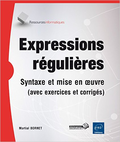GNU/Linux man pages
Livre :
Expressions régulières,
Syntaxe et mise en oeuvre :


GNU/Linux |
CentOS 2.1AS(Slurm) |
|
 |
namei(1) |
 |
namei - follow a pathname until a terminal point is found
namei [-mx] pathname [ pathname ... ]
Namei uses its arguments as pathnames to any type of Unix file (symlinks, files, directories, and so forth). Namei then follows each pathname until a terminal point is found (a file, directory, char device, etc). If it finds a symbolic link, we show the link, and start following it, indenting the output to show the context.
This program is useful for finding a "too many levels of symbolic links" problems.
For each line output, namei outputs a the following characters to identify the file types found:
f: = the
pathname we are currently trying to resolve
d = directory
l = symbolic link (both the link and it’s contents are
output)
s = socket
b = block device
c = character device
- = regular file
? = an error of some kind
Namei prints an informative message when the maximum number of symbolic links this system can have has been exceeded.
|
-x |
Show mount point directories with a ’D’, rather than a ’d’. | ||
|
-m |
Show the mode bits of each file type in the style of ls(1), for example ’rwxr-xr-x’. |
Roger Southwick (rogers@amadeus.wr.tek.com)
To be discovered.
Namei will follow an infinite loop of symbolic links forever. To escape, use SIGINT (usually ^C).
ls(1), stat(1)
 |
namei(1) |  |